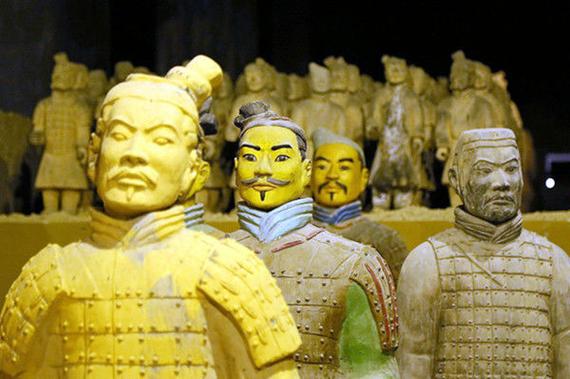
Were the Terracotta Warriors Originally Painted in Bright Colors?
The Terracotta Army, standing guard over the tomb of China's first emperor, Qin Shi Huang, is an awe-inspiring sight. We are used to seeing ranks upon ranks of these warriors in their imposing, yet monotone, earthen hues. But this was not their original appearance. Imagine, instead of the muted colors of clay, a supernatural display swathed in a riot of bold colors: red and green, purple and yellow. Qin's army of clay soldiers and horses was not a somber procession but a spectacle designed to awe and inspire. Sadly, most of these once vibrant colors did not survive the crucible of time—or the exposure to air that comes with discovery and excavation.
A Symphony of Color Lost to Time
Archaeological evidence suggests that the Terracotta Army was originally painted with a wide array of bright pigments, transforming the figures into a lifelike army. These colors were not merely decorative but held symbolic significance, reflecting the elaborate rank and regimental distinctions within Qin Shi Huang's vast army.
- Red: A dominant color, used for robes, armor details, and weaponry. Red symbolized power, good luck, and high status.
- Green: Often used for clothing and banners, green represented growth, prosperity, and the east.
- Purple: A rare and expensive pigment, purple was reserved for high-ranking officers and signified nobility, royalty, and wisdom.
- Yellow: Associated with the earth and the emperor, yellow adorned the clothing and accessories of figures of high importance.
- Blue and Black: Used for details like hair, eyes, and weaponry, adding further realism to the figures.
The paints used were derived from natural materials like minerals, plants, and even insects. Cinnabar provided the brilliant red, azurite the blue, malachite the green, and orpiment the yellow. These pigments were mixed with binders like animal glue or lacquer, creating a paint that adhered well to the porous terracotta surface.
The Fleeting Nature of Brilliance
Upon excavation, archaeologists were met with tantalizing glimpses of this painted past. Patches of pigment clung to the figures, revealing the original vibrancy. However, exposure to air proved disastrous. The organic binders that held the paint together deteriorated rapidly upon contact with oxygen, causing the paint layers to flake and crumble away within minutes. This rapid deterioration makes the preservation of any remaining color a painstaking and challenging task.
Ongoing Efforts to Preserve a Colorful Past
Today, scientists and conservationists are locked in a race against time, working to develop methods to preserve and stabilize the remaining traces of color. Advanced techniques, including:
- Digital reconstruction: Utilizing advanced imaging technology and remaining pigment fragments to digitally recreate the original color scheme of the figures.
- Controlled environments: Storing and displaying the figures in carefully controlled environments with regulated temperature, humidity, and oxygen levels to prevent further deterioration.
- New preservation materials: Constantly researching and experimenting with new preservation materials and techniques to stabilize the remaining pigments and prevent further loss.
While the original splendor of the Terracotta Army’s colors may be largely lost to time, the ongoing research and conservation efforts offer a glimpse into the past and the remarkable artistry of ancient Chinese craftspeople.
Q&A
1. Why did the colors on the Terracotta Army fade?
The organic binders used in the paint deteriorated rapidly upon exposure to oxygen, causing the pigments to flake off.
2. What colors were used on the Terracotta Army?
The army was painted with various colors, including red, green, purple, yellow, blue, and black, each carrying symbolic meaning and denoting rank and status.
3. Are there any efforts to restore the original colors?
While restoring the colors in their entirety is impossible, experts use digital reconstruction techniques and advanced preservation methods to stabilize remaining pigments and digitally recreate the army’s original appearance.